How to Start an E-commerce Business in 2024: 6 Actionable Steps

Have you ever scrolled through Instagram and thought, “Hey, I could sell that!” or do you have a killer product idea? Or probably the process of how to start an eCommerce business looks like impossible?
Well, good news – the online shopping world in India is exploding, and there’s a space for you, too! This guide cuts through the jargon and gives you the 6 essential steps to launching your own eCommerce store.
We’ll show you how to find the perfect product, build a killer online store, and attract customers – all without the headache. So ditch the 9-to-5 and join the e-commerce revolution! Let’s turn your business idea into a reality together.
Let’s understand eCommerce business, how it works, and its types to help you choose the right one for your business.
What is an eCommerce business?
An e-commerce business is simply one that operates online, purchasing and selling products or services via the Internet. Think of your favorite store, but instead of visiting a physical storefront, you explore merchandise and make purchases through their website or mobile app.
E-commerce businesses can be large or small, selling everything from clothing and gadgets to handcrafted goods and advisory services.
How does eCommerce business work?
Here’s how an eCommerce business works in a few steps:
- Customer browses: A potential customer goes to your online store via a website or app.
- Product selection: They browse your products and add favorites to a virtual shopping cart.
- Checkout: When satisfied with their selections, they proceed to the checkout and securely complete their payment information.
- Order processing: You receive the order notification and prepare it for shipping.
- Delivery: You package the order and ship it to the customer’s address.
Types of eCommerce business
There are 4 types of eCommerce businesses:
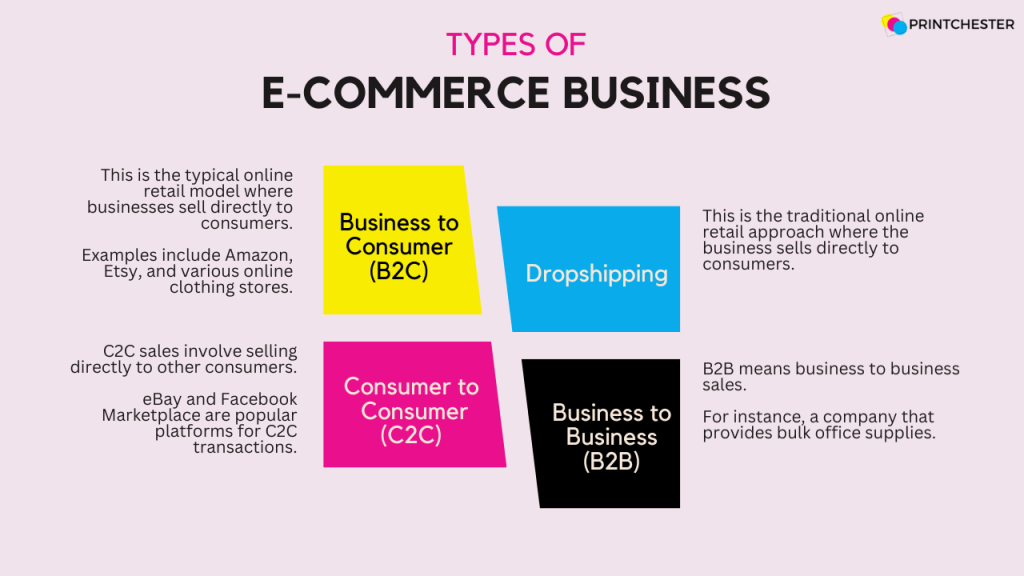
1. Business to Consumer (B2C)
This is the traditional online retail approach. You (the business) sell directly to consumers. Amazon, Etsy, and the majority of online clothing businesses are prime examples.
2. Consumer-to-Consumer (C2C)
This is when individuals sell directly to other customers. Platforms such as eBay and Facebook Marketplace allow C2C sales.
Dropshipping is a fulfillment method in which you do not keep any physical inventory. When a consumer orders a product from your store, you send it to a third-party supplier, who ships it straight to the customer. Dropshipping allows you to launch an online store with little upfront expenditures and explore a wider variety of products without risk.
4. Business-to-Business (B2B)
Business-to-Business refers to selling products or services to other businesses. Consider a company that provides office supplies to other businesses in bulk. Platforms like IndiaMART and Udaan are a few examples.
How to start an eCommerce business?
Step 1 - Choose your eCommerce niche: The foundation of your online business
Finding the right niche is like finding a hidden gem in a treasure chest; it determines the route of your e-commerce journey and shapes your future success. But, with such a wide internet marketplace, how can you narrow down your options and choose a profitable and exciting niche?
Here’s your action plan, packed with actionable ideas to guide you:
A. Exploring Your Passions and Identifying Opportunities:
Self-reflection:
Start by looking inward! What are you passionate about? Do you have any interests or areas of expertise that would translate successfully into products? Perhaps you excel in creating beautiful art or creating one-of-a-kind jewelry. Your existing skills and interests might be a goldmine of niche ideas.
Problem-solving skill:
Consider the pain spots you encounter in your regular life. Is there a product you wish existed or an existing product that could be improved? Identifying market gaps and providing creative solutions can be a successful niche strategy.
B. Researching & Validating Your Niche: Dive Deep Before You Leap
Keyword research tools:
Dive into the realm of keyword research tools, such as Google Trends and Ahrefs. These tools allow you to measure the search volume for specific keywords linked to your niche ideas.
High search traffic suggests possible client interest, but be aware of extremely competitive keywords; maintaining a balance is essential.
Competitor analysis:
Don’t be afraid to look at your competition! Investigate established businesses in your niche and analyze their strengths and flaws.
👉🏻What do they do well?
👉🏻Where do you have the opportunity to stand out?
Learning from the competition enables you to develop a winning plan from the beginning. Begin by exploring markets such as Flipkart and Amazon. Look for top-selling products and experienced sellers in your niche. Study their product groups and offerings.
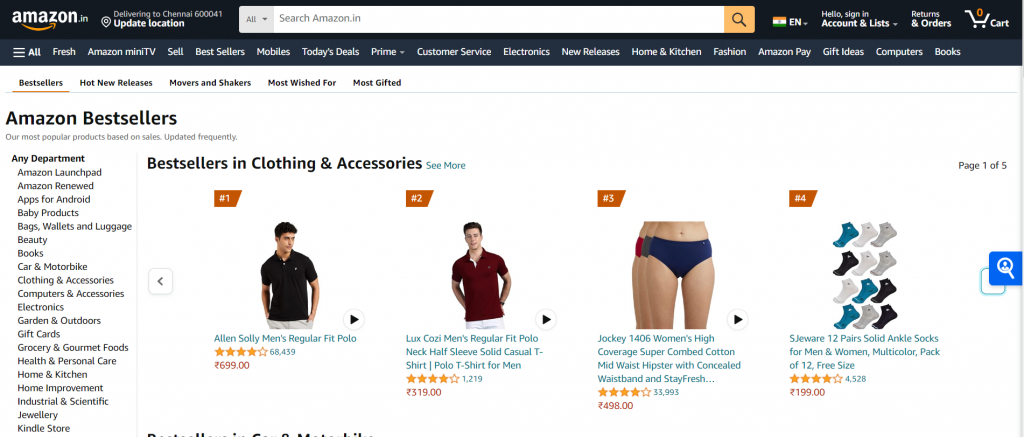
Go to each marketplace’s bestseller page, which is always well-categorized. For example, electronics, clothing, accessories, home, and kitchen items.
Consider their products, pricing approach, and brand image. Can you offer a more specialized product range, a more competitive price point, or a more focused marketing strategy?
Community Exploration:
Online forums, social media groups, and industry journals dedicated to your niche can be extremely useful resources. Look around these online groups for conversations, queries, and pain points mentioned by potential customers.
This insider knowledge can be extremely valuable for identifying customer wants and improving your niche idea.
Actionable tips to secure your niche
Remember that selecting a niche is an important first step, but it is not set in stone. As your business expands, you can expand your product offerings inside your niche or explore similar niches.
The idea is to build a solid foundation based on your interests, market research, and a touch of cautious risk-taking. This will allow you to create your eCommerce empire on a solid and lasting foundation.
Step 2 - Choose the right type of eCommerce business: Picking your perfect path
Now that you’ve discovered your niche jewel, choose the e-commerce business strategy that best fits your resources, talents, and risk tolerance. Here’s a rundown of the most popular models in India, along with some recommendations to assist you in choosing the ideal path:
Business-to-Consumer (B2C):
Ideal for selling a wide range of products directly to consumers. Requires product sourcing, inventory management, and marketing savvy.
Business-to-Business (B2B):
Caters to entrepreneurs with industry expertise, focusing on selling products or services to other businesses in larger quantities. Building relationships and competitive pricing are key.
Customer-to-Customer (C2C):
Perfect for individuals with unique products. Requires high-quality products, trust-building, and some marketing finesse.
Dropshipping:
This model is a great option for entrepreneurs who want to start an online store with minimal upfront costs. It’s suitable for those comfortable with marketing and customer service but who don’t want to manage physical inventory. Finding reliable suppliers and accepting lower margins are crucial.
Expanding Your Options: Additional Ecommerce Business Models
The world of eCommerce offers various models beyond the core categories. Here are a few additional options to consider:
This model allows you to create custom-designed products (t-shirts, mugs, phone cases) without holding physical inventory. You partner with a POD printing company like Printchester that fulfills orders based on your designs. It’s a great option for artists, designers, or anyone with creative ideas for merchandise.
Private Labeling:
This involves developing your own brand identity for a product that’s manufactured by a third party. You’ll design the packaging and marketing materials while the manufacturer handles production. Private labeling offers more control over branding and potentially higher profit margins compared to dropshipping.
Subscriptions:
This model offers recurring revenue by providing customers with products or services delivered at regular intervals (e.g., beauty boxes, pet food subscriptions). It requires strong customer retention strategies and excellent fulfillment processes.
Wholesaling:
Here, you buy products in bulk at a discounted price from a wholesaler and then resell them on your online store
Step 3 - Product sourcing: Fueling your eCommerce business
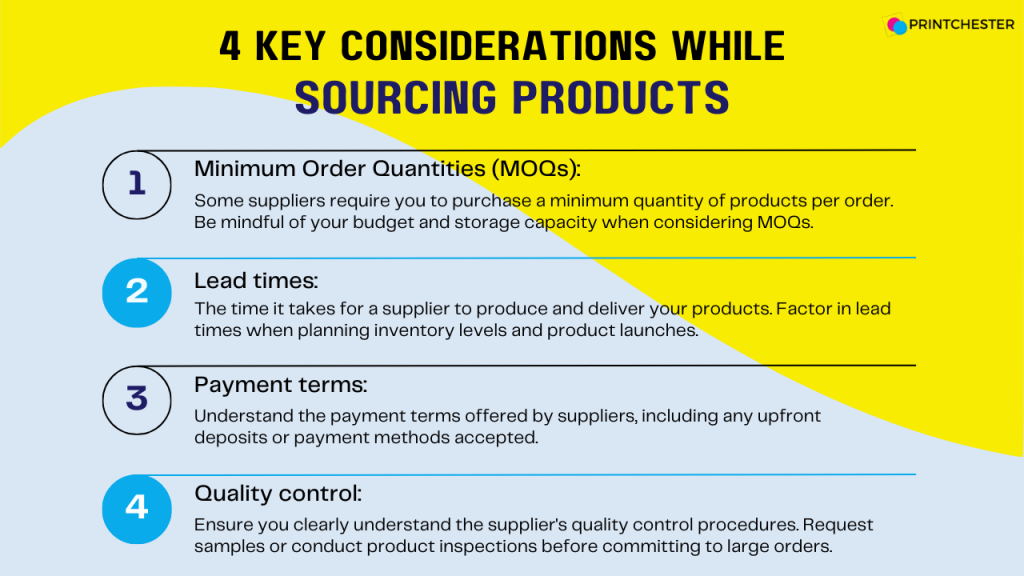
With your niche identified and your business model chosen, it’s time to tackle the heart of your online store – product sourcing! Finding reliable suppliers who can provide high-quality products at competitive prices is fundamental to your ecommerce success.
Here’s a breakdown of popular sourcing options in India, along with their advantages and considerations:
Traditional sourcing:
1. Wholesale:
Advantages: Purchase products in bulk at a discounted price, allowing for higher profit margins.
Considerations: Requires significant upfront investment, storage space for inventory, and managing inventory levels.
Action tip: Research wholesale suppliers online or attend trade shows to discover potential partners.
Examples: You could source clothing in bulk from wholesale suppliers in Tirupur, a textile hub in South India, or electronics from wholesale markets in Delhi.
2. Manufacturing:
Advantages: Highest level of control over product quality, branding, and customization.
Considerations: Requires huge upfront investment in production processes, minimum order quantities (MOQs) might be high, and may involve longer lead times. You can checkout Printchester for manufacturing apparel and shipping services as they are known for eCommerce businesses.
Action tip: Connect with local manufacturers or explore online platforms that connect businesses with manufacturers in India
Modern Sourcing Techniques:
3. Dropshipping:
Advantages: Low upfront costs, no need to manage inventory, allows for a wider product range without investment.
Considerations: Lower profit margins due to supplier markups, limited control over product quality and shipping times, reliance on dropshipping supplier’s reliability. Printchester’s dropshipping solutions are highly reliable to start or grow your eCommerce business hasslefree.
Action tip: Thoroughly research potential dropshipping suppliers, considering factors like product quality, shipping speed, and customer service reputation.
4. Print on Demand (POD):
Partner with a POD services like Printchester to create custom products like t-shirts, hoodies, or oversized t-shirts without holding inventory. You only pay for the products you sell, making it a great option for artists and designers.

5. Private Labeling:
Partner with a manufacturer to develop your own brand for a manufactured product. This offers more control and potentially higher profits than dropshipping, but requires upfront investment in design and branding. Printchester also provides white-labelling services to help you start a brand.
Actionable tips:
Step 4 - Craft Your Brand Identity & Build Your Online Store
It’s time to craft the face of your brand and build your online store – the soul of your ecommerce empire! Here’s a roadmap to guide you through these crucial steps:
1. Name like a pro:
Your business name is your first impression, so choose wisely! Here are some tips:
- Keep it short, memorable, and easy to spell. A long and complicated name will be difficult for customers to remember and find online.
- Make sure it reflects your brand and niche. Your name should give customers a hint about the kind of products or services you offer.
- Check for domain name and trademark availability. Securing a domain name that matches your business name is crucial for online visibility. Similarly, avoid trademark conflicts to prevent legal hassles down the line.
Tools: Use tools like Shopify brand name generator, Looka (AI Powered) to get ideas.
Actionable tips:
Brainstorm name ideas that resonate with your niche and brand personality. Use online business name generators for inspiration, but always check for domain and trademark availability.
Tools: Use tools like Shopify brand name generator, Looka (AI Powered) to get ideas.
2. Design a winning logo:
Your logo is a visual representation of your brand. Here’s what to consider:

Actionable tips:
Action Tip: Consider hiring a graphic designer for a professional logo, or explore user-friendly online logo creation tools like Adobe, Design.com, Fiverr.
3. Build your online store:
There are numerous ecommerce platforms to choose from, each with its own strengths and features. Here are some popular options in India:
- Shopify: A user-friendly platform with a wide range of features and scalability options, perfect for businesses of all sizes.
- WooCommerce (integrates with WordPress): A popular open-source option that provides a high degree of customization for technically savvy users.
- Flipkart Marketplace: A leading Indian marketplace platform, offering a large customer base and established infrastructure.
- Amazon Marketplace: A global giant with a massive reach, but also intense competition.
Actionable tips:
Research and compare different platforms based on your budget, technical expertise, and desired features. Consider factors like ease of use, scalability, payment processing options, and marketing tools.
Bonus Tip:
Many platforms offer free trials, so you can experiment and find the perfect fit for your store before committing.
4. Building Your Throne:
Once you’ve chosen your platform, the fun part begins – building your online store! Here are some key aspects to focus on:
- Product Listings:
Craft compelling product descriptions that highlight the features and benefits of your offerings. Don’t underestimate the power of high-quality product photos – clear and professional images are essential for grabbing customer attention and showcasing your products in the best light.
- User Experience (UX):
Make sure your website is user-friendly, with a clean and intuitive interface. Easy navigation is key to ensuring a smooth shopping experience for your customers. Responsiveness across different devices (desktop, mobile, tablet) is crucial in today’s mobile-first world.
- Payment Gateway:
Integrate a secure payment gateway to accept online payments from customers. Popular options in India include Razorpay, Paytm, and Cash on Delivery (COD).
- Customer Service:
Establish clear communication channels for customer inquiries and support. Respond promptly to questions and concerns, and strive to provide excellent customer service to build trust and loyalty.
Remember:
Building a successful ecommerce store takes time and effort. Don’t be afraid to start small, refine your approach as you learn from customer feedback and data, and constantly strive to improve the customer experience.
With a well-defined brand identity, a user-friendly online store, and a dedication to customer satisfaction, you’re well on your way to building a thriving ecommerce empire that stands out in the ever-growing online marketplace!
Step 5: Legally Lock it Down - Registering Your Ecommerce Business in India
Congratulations! You’ve reached a crucial step in your ecommerce journey – legally registering your business. Operating within the legal framework ensures peace of mind, fosters trust with customers, and opens doors to future growth opportunities. Here’s a breakdown of the essential steps for ecommerce business registration in India:
1. Choose Your Business Structure:
The first step is to select the most suitable legal structure for your business. Here are the most common options for ecommerce businesses in India:
Sole Proprietorship: Simplest structure, ideal for small businesses with one owner. However, the owner bears unlimited liability for business debts.
Partnership: Formed by two or more individuals who share profits and losses. Offers more flexibility than a sole proprietorship but comes with shared liability.
Limited Liability Company (LLC): Provides limited liability protection for owners, separating personal assets from business liabilities. A popular choice for eCommerce businesses due to the balance between flexibility and protection.
Action tip:
Consult with a lawyer or financial advisor to determine the most suitable business structure based on your needs and future plans.
2. Obtain a PAN Card:
A Permanent Account Number (PAN) is essential for any business in India. It acts as a unique identification number for tax purposes. You can apply for a PAN card online or through designated authorities.
3. Tax Registration:
Goods and Services Tax (GST): Most ecommerce businesses need to register for GST if their annual turnover exceeds ₹20 lakh (₹10 lakh for certain northeastern states and Himachal Pradesh). GST registration allows you to collect and deposit GST on your sales.
Income Tax: Depending on your business structure and income levels, you may need to register for income tax and file tax returns.
Action tip:
Utilize online resources provided by the MCA (https://www.mca.gov.in/content/mca/global/en/home.html) and the Goods and Service Tax Council (https://gstcouncil.gov.in/) for detailed information and guidance on the registration processes. Many legal and accounting firms also offer assistance with business registration and tax compliance.
Additional Considerations:
1. Business Bank Account: Open a dedicated bank account for your business transactions to maintain clear separation between personal and business finances.
2. Licenses and Permits: Depending on your niche or product category, you may require additional licenses or permits to operate legally. Research any specific licenses or permits applicable to your business activity.
By following these steps and seeking professional advice if needed, you can ensure your ecommerce business is legally compliant and ready to thrive in the Indian market. Remember, staying compliant fosters trust with customers, allows you to accept online payments seamlessly, and paves the way for future growth and expansion.
Step 6: Power Up Your Sales Engine - Marketing & Customer Acquisition Strategies
Now it’s time to unleash the power of marketing and attract eager customers to your ecommerce haven! Here are some effective strategies to ignite your sales engine and take your business forward:
1. Content Marketing: The Foundation of Trust and Authority
SEO Optimization:
Craft compelling product descriptions and website content enriched with relevant keywords to improve your search engine ranking and organic visibility. This makes it easier for potential customers to find you online when they search for products in your niche.
Blog Engagement:
Establish yourself as a thought leader in your niche by creating informative and engaging blog posts that address customer pain points and showcase your expertise. Offer valuable content like buying guides, DIY tutorials, or industry trends to educate and build trust with potential customers.
Social Media Savvy:
Leverage the power of social media platforms like Instagram, Facebook, and Twitter to connect with potential customers, showcase your products, and build brand awareness.
Here are some specific tactics:
Run targeted ads: Reach a highly relevant audience based on demographics, interests, and online behavior.
Engage in conversations: Respond to comments, answer questions, and participate in discussions to build relationships with potential customers.
Participate in relevant online communities: Join Facebook groups or online forums related to your niche to connect with potential customers and establish yourself as an expert.
2. Paid Advertising Strategies: Targeted Reach and Growth
Pay-Per-Click (PPC) Advertising: Utilize platforms like Google Ads or social media advertising to target specific demographics and interests with laser focus. PPC ads can drive high-quality traffic to your online store and convert curious visitors into paying customers.
Influencer Marketing: Partner with relevant influencers in your niche to promote your products to their engaged audience. This can be a powerful way to reach a wider audience and leverage the trust established by the influencer. Choose influencers whose audience aligns with your target market and ensure their content and brand image resonate with your brand identity.
3. Email Marketing Magic: Nurturing Leads and Building Loyalty
Build an Email List: Encourage visitors to subscribe to your email list with enticing offers or valuable content like downloadable guides, early access to sales, or exclusive discounts.
Targeted Email Campaigns: Craft personalized email campaigns that resonate with your subscribers’ interests and purchase journey stages. Here are some ideas:
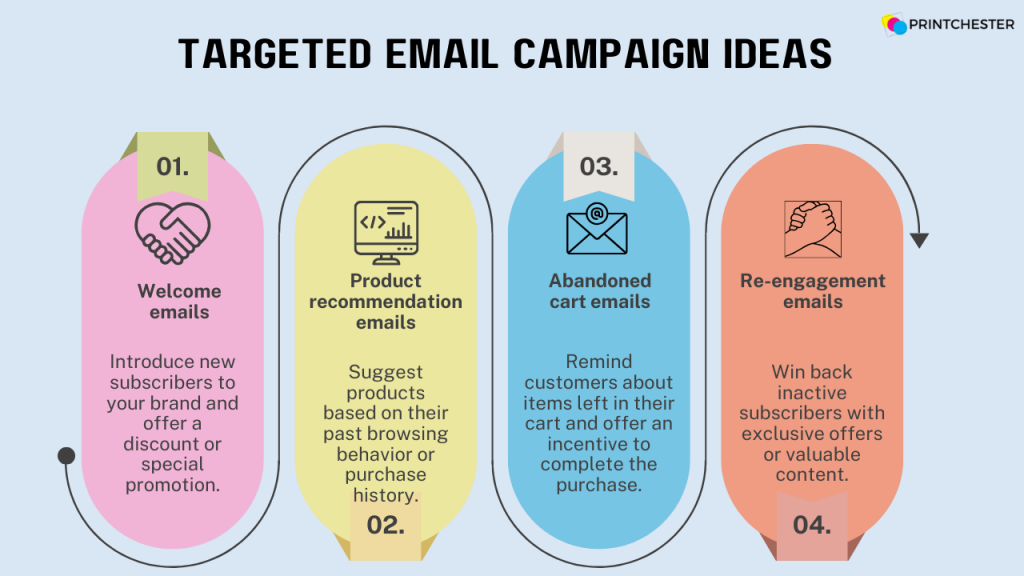
4. Customer Reviews & Social Proof: Building Trust and Confidence
Encourage Customer Reviews:
Positive customer reviews are like gold for an ecommerce business. Incentivize customers to leave reviews (e.g., discounts, loyalty points) and showcase them prominently on your website and product pages.
Social Proof Power:
Utilize social proof elements like customer testimonials, case studies, or user-generated content (UGC) to build trust and encourage conversions. Here are some ways to leverage UGC:
- Run contests or challenges that encourage customers to share photos or videos using your products.
- Feature customer photos or videos on your website and social media channels.
- Showcase positive customer reviews and testimonials throughout your online store.
Action tip:
Don’t try to conquer every marketing strategy at once! Start by focusing on a few channels that align well with your target audience and budget. Here are some questions to guide your decision:



As you gain experience and data insights from your marketing efforts, you can refine your approach and experiment with new strategies to optimize your customer acquisition efforts.
Remember, marketing is an ongoing journey – not a one-time destination. Analyze your results, adapt your strategies based on data and customer feedback, and continuously strive to refine your approach.
How to start an eCommerce business with Printchester?
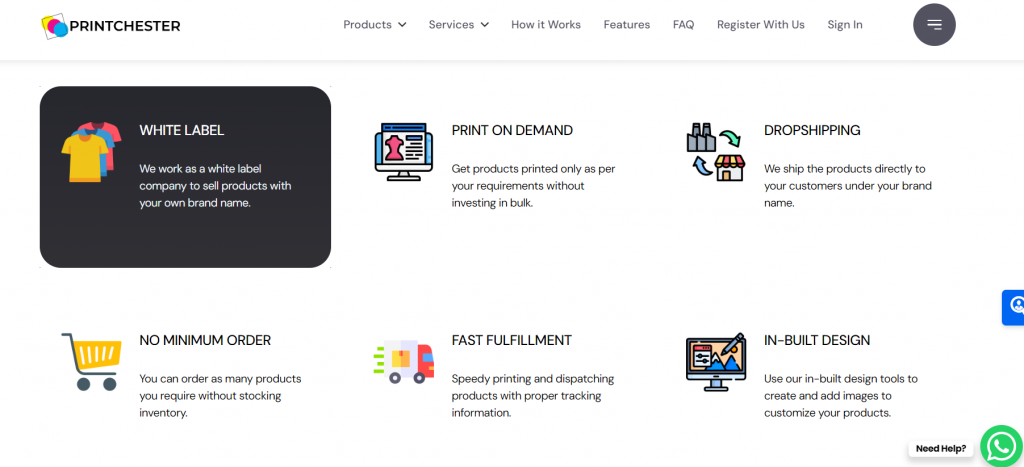
Launching your ecommerce business with Printchester is straightforward! Here’s a quick guide:
Plan & Design: Choose your apparel niche, design your eye-catching graphics, and decide on your profit margins.
Create Your Store: Select an ecommerce platform like Shopify or Woocommerce and set up your online store. Integrate Printchester’s service for seamless product creation and fulfillment.
Stock Your Store (Virtually): Add your Printchester-integrated products to your online store. No need to hold physical inventory!
Market Your Brand: Leverage social media, SEO optimization, and other marketing strategies to attract customers to your online store.
Sit Back & Relax (Almost): Once a customer orders, Printchester handles printing, packaging, and shipping directly to your customer. You manage orders and watch your business flourish!
Frequently Asked Questions
Printchester focuses on high-quality apparel products that you can customize and sell under your brand. This includes:
- T-shirts: Offered in various styles like crew neck and oversized fits.
- Sweatshirts: Cozy options like crewnecks and hoodies for a wider customer appeal.
- Hoodies: A popular choice for custom designs in various colors and styles.
- Crop tops: Perfect for summer collections or activewear designs.
No worries! Create helpful content, engage on social media, and get your website seen in searches.
No, the biggest advantage of Printchester POD is the elimination of upfront inventory investment. You only pay for the apparel items that sell after a customer places an order on your online store.
Printchester charges a per-garment fee that covers printing, packaging, and fulfillment. The exact cost depends on the specific apparel type, size, and the number of colors in your design. You can find their up-to-date pricing structure on their website or merchant dashboard to calculate your profit margins.
Absolutely! You set the selling price for your products on your online store. The difference between your selling price and Printchester’s per-product fee determines your profit margin.
